The jury of the 58th annual World Press Photo Contest has selected an image by Danish photographer Mads Nissen as the World Press Photo of the Year 2014.
The World Press Photo is an independent, non-profit organisation based in Amsterdam, Netherlands. The organisation is known for holding the world's largest and most prestigious annual press photography contest.
The premier award carries a cash prize of 10,000 euros. The prize-winning pictures are presented in an exhibition visiting around 100 cities in about 45 countries. The first 2015 World Press Photo exhibition opens in Amsterdam in De Nieuwe Kerk on 18 April 2015.
First Prize Contemporary Issues, Singles

Image: Jon and Alex, a gay couple, during an intimate moment. Life for lesbian, gay, bisexual or transgender people is becoming increasingly difficult in Russia. Sexual minorities face legal and social discrimination, harassment, and even violent hate-crime attacks from conservative religious and nationalistic groups. Photograph: Mads Nissen, Denmark, Scanpix/Panos Pictures
First Prize Portraits Category, Singles
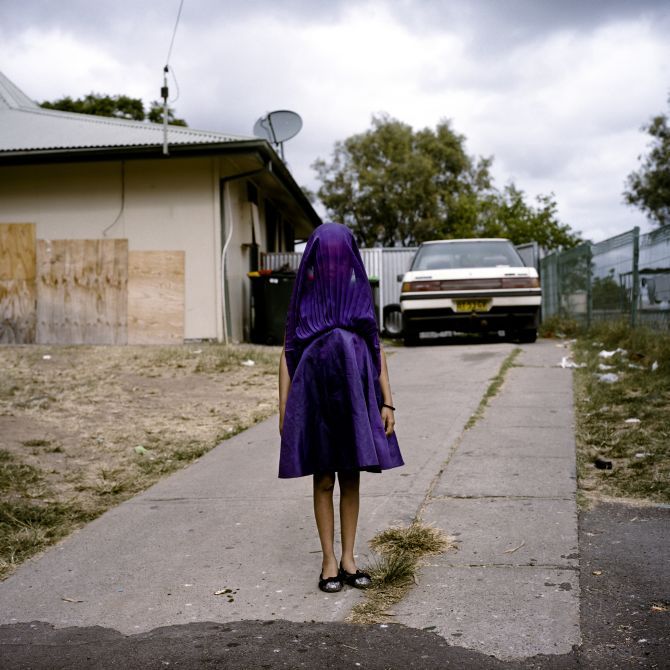
Image: Laurinda waits in her purple dress for the bus that will take her to Sunday School. She is among the many socially isolated young women in disadvantaged communities in Australia facing entrenched poverty, racism, trans-generational trauma, violence, addiction, and a range of other barriers to health and well-being. Photograph: Raphaela Rosella, Australia, Oculi
Second Prize Daily Life Category, Singles

Image: Twin brothers Igor and Arthur hand out chocolates to their classmates to celebrate their ninth birthday. When they were two years old, their mother traveled to Moscow to work in the construction field and later died. They have no father. They are among thousands of children growing up without their parents in the Moldovan countryside. Young people have fled the country, leaving a dwindling elderly population and young children. Photograph: Åsa Sjöström, Sweden, Moment Agency / INSTITUTE for Socionomen / UNICEF
Second Prize Daily Life Category, Stories

Image: John wears his grandson’s bowler hat
Story: It was in the afternoon. I was sitting on my grandpa’s couch. The door was slightly open, and I saw light coming through, washed out between the white door and white walls. All of a sudden it all started making sense. I could relate what I was seeing with what I felt. John and Prova, my grandparents. Growing up, I found much love and care from them. They were young and strong.
As time went by, it shaped everything in its own way. Bodies took different forms and relations went distant. Grandma’s hair turned gray, the walls started peeling off and the objects were all that remained. Everything was contained into one single room. They always love the fact that I take pictures of them because then I spend more time with them, and they don’t feel lonely anymore. After Prova passed away, I try to visit more so John can talk. He tells me stories of their early life, and how they met. There are so many stories. Here, life is silent, suspended. Everything is on a wait; A wait for something that I don’t completely understand. Photograph: Sarker Protick, Bangladesh
First Prize General News Category, Singles

Image: Damaged goods lie in a kitchen in downtown Donetsk. Ordinary workers, miners, teachers, pensioners, children, and elderly women and men are in the midst of the conflict in eastern Ukraine. Artillery fire killed three people and wounded 10 on 26 August 2014. Photograph: Sergei Ilnitsky, Russia, European Pressphoto Agency
Second Prize Contemporary Issues Category, Singles
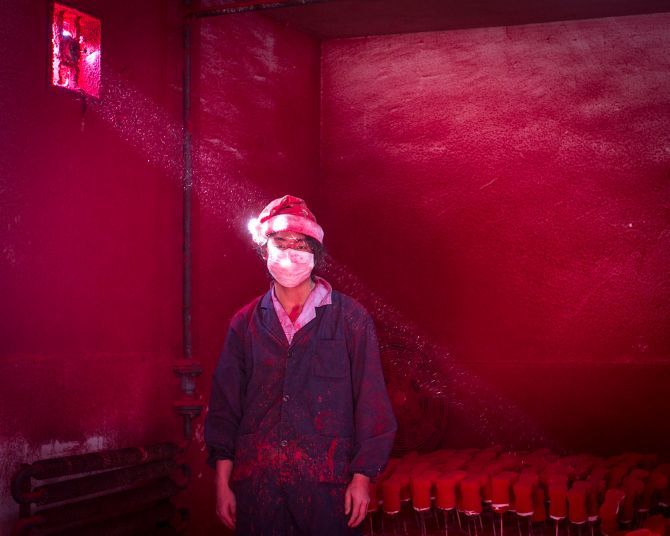
Image: Wei, a 19-year-old Chinese worker, wearing a face mask and a Santa hat, stands next to Christmas decorations being dried in a factory as red powder used for coloring hovers in the air. He wears six masks a day and the hat protects his hair from the red dust, which covers workers from head to toe like soot after several hours of work. Photograph: Ronghui Chen, China, City Express
Second Prize Sports Category, Singles
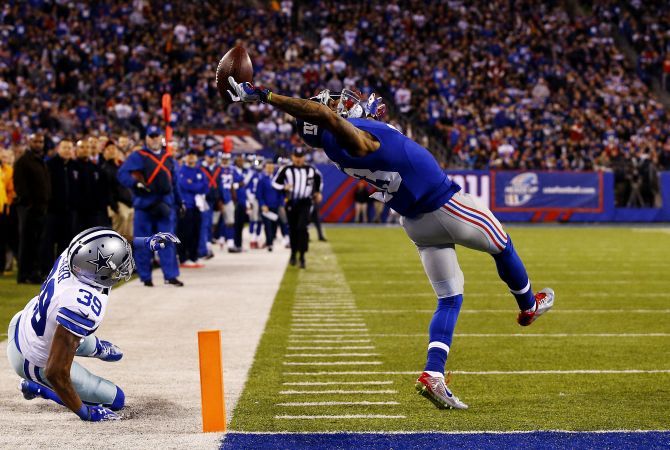
Image: Odell Beckham (#13) of the New York Giants makes a one-handed touchdown catch in the second quarter against the Dallas Cowboys at MetLife Stadium. Photograph: Al Bello, USA, Getty Images
Third Prize Portraits Category, Stories

Image: Cadet in the Koninklijke Militaire Academie Story: Portraits of cadets from the most important military academies of Europe. Photograph: Paolo Verzone, Italy, Agence Vu
First Prize Nature Category, Stories
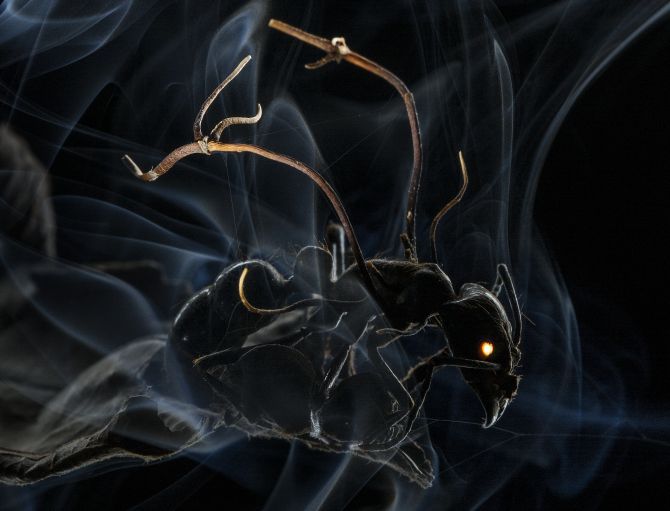
Image: When spores of the fungus land on an ant, they penetrate its exoskeleton and enter its brain, compelling the host to leave its normal habitat on the forest floor and scale a nearby tree. Filled to bursting with fungus, the dying ant fastens itself to a leaf or another surface. Fungal stalks burst from the ant's husk and rain spores onto ants below to begin the process again. Photograph: Anand Varma, USA, for National Geographic Magazine
Third Prize Contemporary Issues Category, Stories
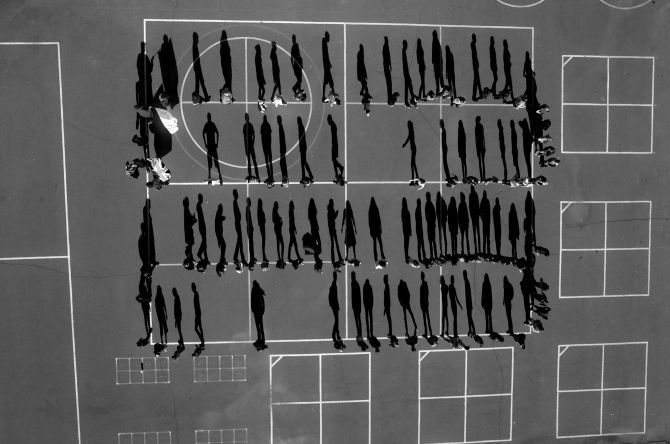
Image: Students in a schoolyard. Story: Several thousand people have been killed by covert U.S. drone strikes since 2004. The photographer bought his own drone, mounted a camera and traveled across the US looking for similar situations as mentioned in strike reports from Pakistan and Yemen, including weddings, funerals, and groups of people praying or exercising. He also flew his camera over settings in which drones are used to less lethal effect, such as prisons, oil fields and the U.S.-Mexico border. Photograph: Tomas van Houtryve, Belgium, VII for Harper’s Magazine
Second Prize Nature Category, Singles
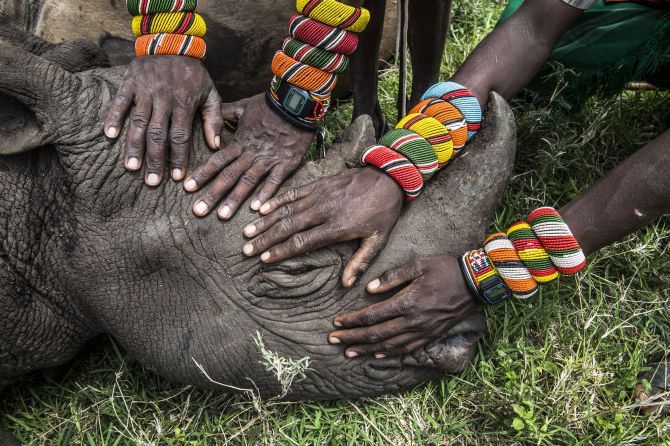
Image: A group of young Samburu warriors encounter a rhino for the first time in their lives. Most people in Kenya never get the opportunity to see the wildlife that exists literally in their own backyard.
Story: Organised by sophisticated, heavily armed criminal networks and fueled by heavy demand from newly minted millionaires in emerging markets, poaching is devastating the great animals of the African plains. Much needed attention has been focused on the plight of wildlife and the conflict between poachers and increasingly militarized wildlife rangers, but very little has been said about the indigenous communities on the frontlines of the poaching wars and the work that is being done to strengthen them. These communities hold the key to saving Africa’s great animals. Photograph: Ami Vitale, USA, National Geographic
First Prize Long-Term Projects
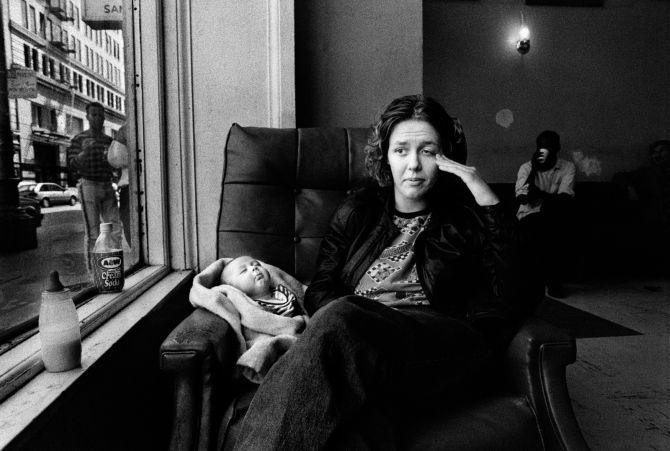
Image: I first met Julie on January 28, 1993. Julie, 18, stood in the lobby of the Ambassador Hotel, barefoot, pants unzipped, and an 8 day-old infant in her arms. She lived in San Francisco’s SRO district, a neighborhood of soup kitchens and cheap rooms. Her room was piled with clothes, overfull ashtrays and trash. She lived with Jack, father of her first baby Rachel, and who had given her AIDS. Her first memory of her mother is getting drunk with her at 6 and then being sexually abused by her stepfather.
She ran away at 14 and became drug addict at 15. Living in alleys, crack dens, and bunked with more dirty old men than she cared to count. “Rachel,” Julie said, “has given me a reason to live.” For the next 21 years I photographed Julie Baird and her family’s complex story of poverty, AIDS, drugs, multiple homes, relationships, births, deaths, loss and reunion. Photograph: Darcy Padilla, USA, Agence Vu
First Prize General News Category, Stories
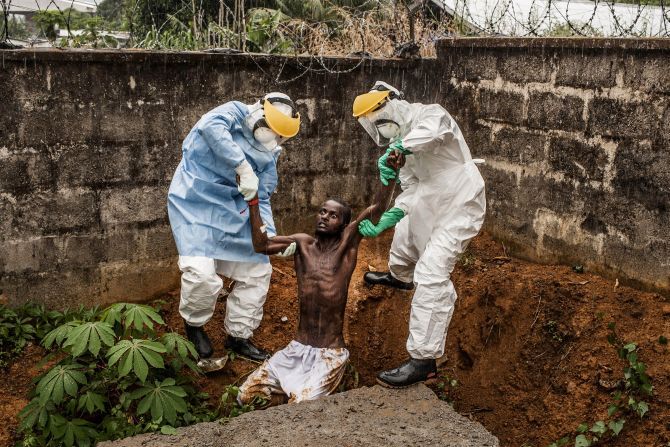
Image: Medical staff at the Hastings Ebola Treatment Center work to escort a man in the throes of Ebola-induced delirium back into the isolation ward from which he escaped. In a state of confusion, he emerged from the isolation ward and attempted to escape over the back wall of the complex before collapsing in a convulsive state. A complete breakdown of mental facilities is a common stage of advanced Ebola. The man pictured here died shortly after this picture was taken. Photograph: Pete Muller, USA, Prime for National Geographic / The Washington Post
Second Prize General News Category, Single
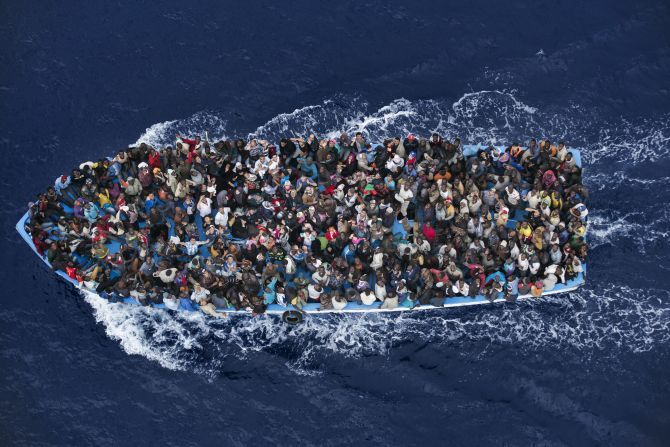
Image: Shipwrecked people are rescued aboard a boat 20 miles north of Libya by a frigate of the Italian navy. After hundreds of men, women and children had drowned in 2013 off the coast of Sicily and Malta, the Italian government put its navy to work under a campaign called “Mare Nostrum” rescuing refugees at sea. Only in 2014, 170,081 people were rescued and taken to Italy. Photograph: Massimo Sestini, Italy
Second Prize Spot News Category, Stories
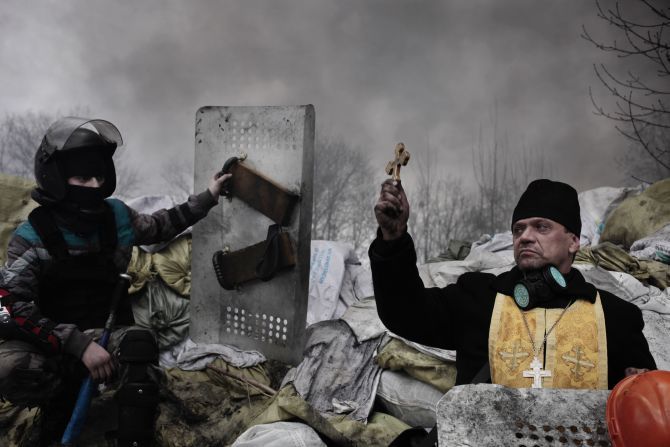
Image: A protester calls for medical aid for a comrade shot dead. Story caption: After several months of violence, anti-government protesters remained mobilized by holding barricades in Kiev’s Independence Square, known simply as the Maidan. On Saturday, 20 February, unidentified snipers opened fire on unarmed protesters as they were advancing on Instituska Street.
According to an official source, 70 protesters were shot dead. Ukrainian riot police claimed that several police officers were wounded or shot dead by snipers as well. An unofficial source said that snipers opened fire on the police and protesters at the same time in order to provoke both camps. 20 February was the bloodiest day of the Maidan protests, and two days after, President Viktor Yanukovych left the country. Photograph: Jérôme Sessini, France, Magnum Photos for De Standaard
First Prize Sports Category, Singles

Image: Argentina player Lionel Messi comes to face the World Cup trophy during the final celebrations at Maracana Stadium. His team lost to Germany 1-0, after a goal by Mario Götze in extra time. Photograph: Bao Tailiang, China, Chengdu Economic Daily
Second Prize General News Category, Stories
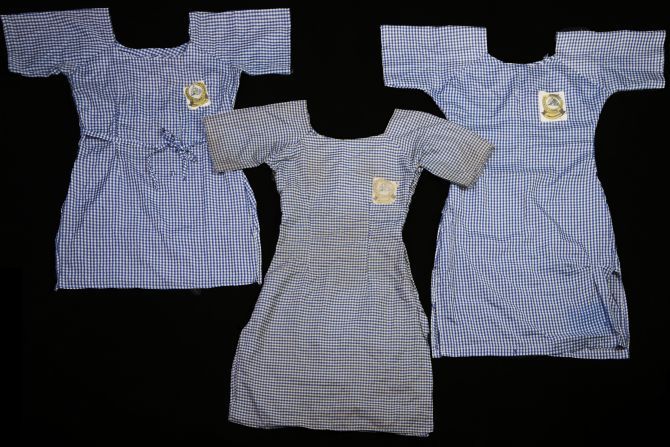
Image: School uniforms belonging to three of the missing girls. Story Caption: In her school notebook, Hauwa Nkeki wrote a letter to her brother: "Dear Brother Nkeki, Million of greetings goes to you thousand to your friend zero to your enemies." Hauwa is one of the nearly 300 girls who were kidnapped by the Islamic militants Boko Haram on 14 April 2014 from their school dormitory in Chibok, a remote village in northern Nigeria. Boko Haram’s name translates roughly to “Western Education is Sinful.” The group believes that girls shouldn’t be in school and boys should only learn the Koran.
For the past few years, Boko Haram has been burning villages to the ground, using forced recruitment and carrying out an ongoing insurgency. Many thousands have died and the region has been devastated. No one took much notice before the girls were kidnapped. In May 2014, a hashtag campaign (#BringOurGirlsBack) became viral on Twitter and swept the globe. Within a week, it had attracted over two million tweets. A media frenzy began and coverage of the protests was extensive. But the thing that’s been missing from most of the coverage is the girls themselves. Photograph: Glenna Gordon, USA
First Prize Spot News Category, Singles
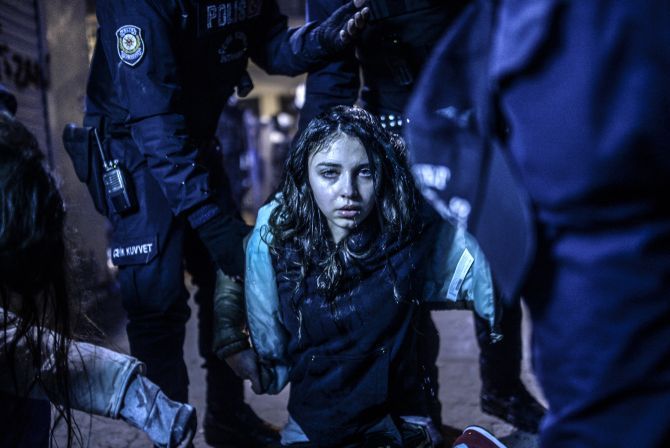
Image: A young girl is pictured after she was wounded during clashes between riot-police and protestors after the funeral of Berkin Elvan, the 15-year-old boy who died from injuries suffered during last year's anti-government protests. Riot police fired tear gas and water cannon at protestors in the capital Ankara, while in Istanbul, crowds shouting anti-government slogans lit a huge fire as they made their way to a cemetery for the burial of Berkin Elvan. Photograph: Bulent Kilic, Turkey, Agence France-Presse
First Prize Nature Category, Singles

Image: A monkey being trained for circus cowers as its trainer approaches. With more than 300 roupes, Suzhou is known as the home of the Chinese circus. Photograph: Yongzhi Chu, China





























